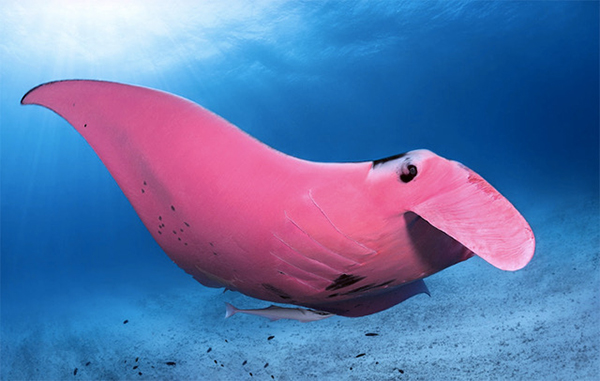Have You Seen This Pink Manta?Contents of this Issue: Roatan Aggressor, Bay Islands, Honduras Stay Away from Those Propellers: The Most Dangerous Thing You Meet is a Boat Who Can Save Dying Reefs? Fish! Climate Change is Eliminating Florida's Male Turtles Raja Ampat, St. Lucia, Rangiroa, Vancouver Island Want to Create Great Videos with Your Action Camera? Instructor Killed by Blasted Tank Valve Have You Seen This Pink Manta? Aqualung Recalls the Exotec BCD Hydration, Diving, and SIPE, the Killer Equipment Checks to Prepare for Diving Editorial Office: Ben Davison Publisher and Editor Undercurrent 3020 Bridgeway, Suite 102 Sausalito, CA 94965 from the November, 2022 issue of Undercurrent
Unfortunately, nobody has seen it since 2019, but they're still looking for it. When photographer Kristian Lane was freediving off Lady Elliot Island, the southernmost island of Australia's Great Barrier Reef, a bright pink manta ray glided by. He thought his eyes were deceiving him. Actually, Inspector Clouseau, as it is nicknamed, was first spotted in 2015 in the same area, and Project Manta's scientists had taken a small skin biopsy. Their leading theory is that the manta has a genetic mutation in its expression of melanin, or pigment. Solomon David, an aquatic ecologist at Louisiana's Nicholls State University, suspects the mutation is a condition called erythrism, which causes an animal's skin pigmentation to be reddish, or in some cases, pink. Guy Stevens, CEO and co-founder of the U.K.-based Manta Trust, agrees that erythrism is the most plausible explanation. But, whatever the cause, it's a wondrous creature, and one can only hope that a lucky diver will spot it again. PS: Kudos to you if you get the manta's connection to Inspector Clouseau. |

I want to get all the stories! Tell me how I can become an Undercurrent Online Member and get online access to all the articles of Undercurrent as well as thousands of first hand reports on dive operations world-wide
| Home | Online Members Area | My Account |
Login
|
Join
|
| Travel Index |
Dive Resort & Liveaboard Reviews
|
Featured Reports
|
Recent
Issues
|
Back Issues
|
|
Dive Gear
Index
|
Health/Safety Index
|
Environment & Misc.
Index
|
Seasonal Planner
|
Blogs
|
Free Articles
|
Book Picks
|
News
|
|
Special Offers
|
RSS
|
FAQ
|
About Us
|
Contact Us
|
Links
|
3020 Bridgeway, Ste 102, Sausalito, Ca 94965
All rights reserved.


